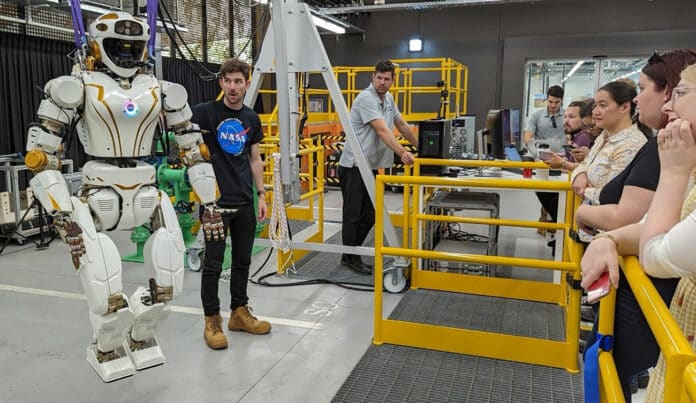NASA’s Valkyrie robot is beginning a new mission half a world away from its home at the agency’s Johnson Space Center in Houston. As part of a reimbursable Space Act Agreement with Woodside Energy in Perth, Western Australia, NASA plans to use a Valkyrie robot to develop remote mobile dexterous manipulation capabilities to accommodate remote caretaking of uncrewed and offshore energy facilities.
Woodside Energy will test the resulting software and provide data and feedback to NASA, helping accelerate the maturation of robotic technology. With this collaboration, Valkyrie will advance robotic remote operations capabilities, improving the efficiency of Woodside’s offshore and remote operations while increasing safety for its personnel and the environment. In addition, the new capabilities may also have applications for NASA’s Artemis missions and other Earth-based robotics objectives.
Weighing 125 kg and standing 6 feet (1.8 meters) tall, Valkyrie is shaped like every one of us, with two legs, arms, a torso, and a head. The robot’s brain comes with a pair of Intel Core i7 processors, while a 1.8 kWh battery handles its energy needs. There are various sensors installed, including infrared, laser, and camera visualization tools.
NASA hopes that the tests conducted in Woodside’s facilities will teach the agency how to better design robots for work in dirty and hazardous conditions, like those found on the Moon at the long-term worksites and habitats that will be established as part of future Artemis missions. Some activities to be undertaken by remotely operated mobile robots on the lunar and Martian surface include inspection and maintenance of infrastructure and plants that leverage resources and materials to produce new items, enabling astronauts to live off the land.
“We are pleased to be starting the next phase of development and testing of advanced robotic systems that have the potential to positively impact life on Earth by allowing safer operations in hazardous environments,” says Shaun Azimi, lead of the dexterous robotics team at NASA Johnson. “These demonstrations will evaluate the current potential of advanced robots to extend the reach of humans and help humanity explore and work safely anywhere.”
Valkyrie and other advanced mobile robots can be vital tools in allowing humans to supervise dangerous work remotely and to offload dull and repetitive tasks, enabling humans to work on higher-level tasks, including deploying and maintaining robots. These principles apply to both space and Earth, where companies are recognizing the value of human-scale robots.
To deliver the robot, the NASA dexterous robotics team from Johnson traveled to the Woodside headquarters in Perth, Western Australia. The team prepared the Valkyrie robot and conducted training with the Woodside team on its operations.
The data and lessons learned from Valkyrie’s development will be applied to current and future robotics and automation development for use in space.
